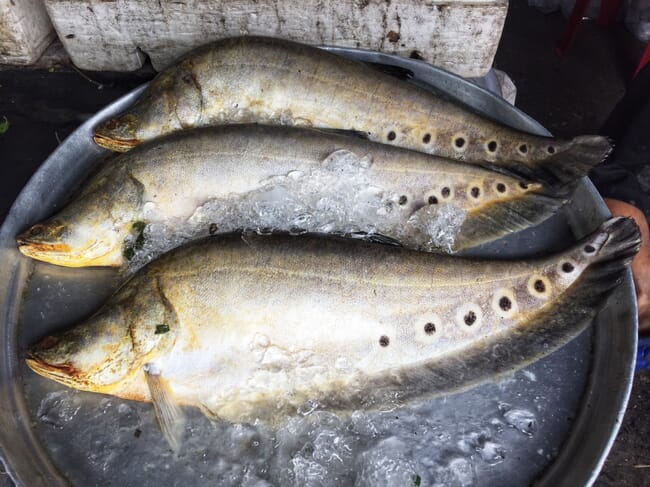
A knifefish can grow up to 100 cm in length and 5 kg in weight, with a single fish requiring 7 kg of different types of fish for every kilogram of growth © Shutterstock
Knifefish (Chitala sp.) is a freshwater species commonly traded as an exotic aquarium fish and very popular among hobbyists. They come from South America and Southeast Asia – specifically from Thailand, Borneo, Malaysia, India and Sumatra – and are usually found in lakes, swamps and river backwaters. They prefer still waters and can survive with low oxygen.
Knifefish were accidentally introduced into Laguna de Bay, the largest lake in the Philippines, during the super typhoon Ondoy (international name: Ketsana) in 2009, which caused flash floods in many parts of the country.
As early as 2011, reports from fisherfolk surfaced regarding knifefish being a pest, as it eats tilapia and bangus, which are two main commodities caught from the lake. The proliferation of knifefish has affected the aquaculture and capture fisheries of the lake, causing the catch and harvest of the fisherfolk to decline dramatically. The bulk of the fisherfolk’s catch comprises now of knifefish, which is not acceptable to them because it does not suffice to their previous income when most of their catch are bangus and tilapia. This is because knifefish only sells for PHP10-20/kg ($0.18-0.36/kg) while bangus or tilapia is usually around PHP100/kg ($1.80/kg) in local markets.
The fish is aggressive, highly carnivorous in nature and naturally breeds in ponds and open waters. In the wild, a knifefish can grow up to 100 cm in length and 5 kg in weight. According to BFAR-National Inland Fisheries Technology Center (BFAR-NIFTC), the fish consumes/requires 7 kg of different types of fish to grow to a kilogram. It also rapidly produces with a fecundity of 20,000 eggs/kg of fish. Knifefish eggs are found attached on stakes and poles of fish cages and fishpens. Once the eggs hatch, the fry remain within the fish cages and pens where they grow and feed on the tilapia and bangus fry and fingerlings. The fish is now considered as an invasive species and a threat to the biodiversity of the lake, particularly to the indigenous species, including silver therapon or ayungin, goby or biya and freshwater shrimp or hipon.
Knifefish as food fish
One of the strategies of BFAR in the containment of knifefish is to explore its economic utilisation, such as the use of knifefish as a raw material in post-harvest. Training is now being conducted particularly to people from the coastal municipalities of Laguna Lake on the value-adding of knifefish.
BFAR IVA’s Fisheries Postharvest Division (FPHD) is now using knifefish as a raw material in making nuggets, burger patties, kikiam and siomai, which are popular finger food in the country. In a technology demonstration held on July 26, 2013 for the people of Sitio Sumilang, Antipolo City, Rizal province, samples of burger patties and nuggets were tasted by the participants, as well as their children (elementary and high school students).
Many of the children commented that the products tasted like chicken while some said that it tasted like pork. The adults said that the meat was soft and tasty. The acceptability of the nuggets (with and without sauce) and patties was high, as shown by the children who kept coming back and asking for more. Some adults took more than a piece and ate them with rice. In another techno-demo held on July 17, 2013, Department of Health employees loved the kikiam and siomai made from knifefish.
According to Ms Escolastica G. Dinapo, head of FPHD, the knifefish meat is a good raw material for value-adding, because it is white, firm and can be easily removed from the skin. Also, the bones of knifefish can be easily removed. Unlike the bighead carp, which is usually used by the FPHD team in their techno-demos, the knifefish need not be rinsed numerous times because it does not have any undesirable odours; it does not smell nor taste “fishy” or malansa. As such, this lessens the steps, time and resources in processing the knifefish.
BFAR IVA’s regional director, Esmeralda Paz D. Manalang, also supports this effort and said that the knifefish in Laguna Lake were tested to be free of heavy metals, which are dangerous to human health.
Other strategies
Aside from value-adding, other strategies being employed by BFAR in the containment of knifefish in Laguna Lake are: the massive collection and retrieval of knifefish and its eggs in coordination with the LGUs and MFARMCs of the coastal municipalities; using knifefish as fish feed – trash fish for snakehead and fish meal ingredients in feeds for pangasius and tilapia (coordination is also being made with other BFAR centres on the usage of knifefish as trash fish for maliputo, mudcrab and grouper); and development of handicraft products using the skin of knifefish.
Fishing gear will also be distributed to fisherfolk to increase retrieval of knifefish from highly affected areas. BFAR is also conducting research on the possible use of electrofishing and the use of dalag to prey on knifefish.
BFAR has also partnered with other agencies, such as the Laguna Lake Development Authority, Department of Social Works and Development, Technical Education and Skills Development Authority and Department of Environment and Natural Resources, among others, to come up with other strategies to eradicate knifefish from the lake.




